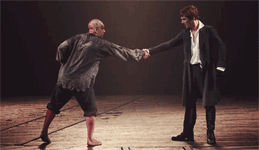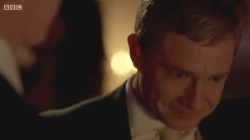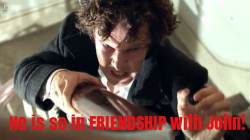
BBC Sherlock Fan Forum - Serving Sherlockians since February 2012.
 1 of 1
1 of 1
- SherlocklivesinOH
- Mycroft's Contact
 Offline
Offline - Registered: January 12, 2014
- Posts: 526
Moffit and Gattis took canon and threw it in a pot and stirred
They pull out elements from multiple stories and put them into one episode.
Example: Irene Adler with compromising information is from "A Scandal in Bohemia," (and Moriarty was nowhere near involved with that) and Holmes demanding to know who his high-profile client is is from "The Illustrious Client." Is the mixing-and-matching necessary?
- Wholocked
- Moderator
 Offline
Offline 
- From: Australia
- Registered: March 7, 2012
- Posts: 1,811
Re: Moffit and Gattis took canon and threw it in a pot and stirred
There's a thread in "It's Canon" forum here: where people have 'collected' all the canon nods in the episodes.
I take it you're not a fan of how they've done it, but I think it's perfect. Some canon stories can't believably be recreated in modern times, so they've taken features from them. It's wonderful.
-------------------------------------------------------------------------------------------------------------
I dislike being outnumbered. It makes for too much stupid in the room

- belis
- Mycroft's Contact
 Offline
Offline - From: Manchester
- Registered: January 13, 2014
- Posts: 401
Re: Moffit and Gattis took canon and threw it in a pot and stirred
Personally I find that it adds to the enjoyment of the show. If it was a straighforward adaptation simply set in modern time I would know what's going to happen after reading the books. The mixing and changing adds an element of surprise.
- SusiGo
- The game is never over (moderator)
 Offline
Offline 
- From: Germany
- Registered: June 5, 2012
- Posts: 22,965
Re: Moffit and Gattis took canon and threw it in a pot and stirred
This is their creative fan-oriented way of dealing with the material. They never denied that they came to ACD as fans and wanted to do something to bring SH into the 21st century. Of course they had to adapt the originals and chose to use elements from different sources for one episode. And I think it is a work of genius how they modernised many elements: turning the orange pips into mobile phone beeps, the parsley in the butter into the flake in the ice-cream cone ... I do not want to have it any other way.
------------------------------
"To fake the death of one sibling may be regarded as a misfortune; to fake the death of both looks like carelessness." Oscar Wilde about Mycroft Holmes
"It is what it is says love." (Erich Fried)
“Enjoy the journey of life and not just the endgame. I’m also a great believer in treating others as you would like to be treated.” (Benedict Cumberbatch)

- SolarSystem
- Threatened Knighthood
 Offline
Offline - From: Germany
- Registered: July 30, 2013
- Posts: 10,650
Re: Moffit and Gattis took canon and threw it in a pot and stirred
I think it would be pretty boring if they took the stories from Canon one by one, it's far more surprising and creative to mix it up and come up with something new.
___________________________________________________
"Am I the current King of England?
"I see no shame in having an unhealthy obsession with something." - David Tennant
"We did observe." - David Tennant in "Richard II"
- SusiGo
- The game is never over (moderator)
 Offline
Offline 
- From: Germany
- Registered: June 5, 2012
- Posts: 22,965
Re: Moffit and Gattis took canon and threw it in a pot and stirred
It would be as boring as an adaptation I will not mention here for fear of being stoned to death. (irony)![]()
------------------------------
"To fake the death of one sibling may be regarded as a misfortune; to fake the death of both looks like carelessness." Oscar Wilde about Mycroft Holmes
"It is what it is says love." (Erich Fried)
“Enjoy the journey of life and not just the endgame. I’m also a great believer in treating others as you would like to be treated.” (Benedict Cumberbatch)

- Schmiezi
- Reichenbach Survivor
 Offline
Offline 
- From: NRW, Germany
- Registered: August 10, 2012
- Posts: 5,478
Re: Moffit and Gattis took canon and threw it in a pot and stirred
SusiGo wrote:
It would be as boring as an adaptation I will not mention here for fear of being stoned to death. (irony)
And while absolutely not referring to this post, let me add that with the Granada series there already is a show that sticks to the canon very closely. ![]()
---------------------------------------------------------------------------------------------------------------------------------------------------------------------------------
I still believe that love conquers all!


"Quick, man, if you love me."
- Be
- Unregistered
Re: Moffit and Gattis took canon and threw it in a pot and stirred
Don't let them know that you suspect them stirring the canon pieces. They might read it and get upset. And you might regret it.
They try to tell a story and use pieces of the Doyle puzzle to paint a picture. I'd like to think that they are authentic and truthful with their approach, but sometimes it clearly looks like a deception played for our mind only.
How can they present us a deception to prove authenticity?
The problem is to have the right perspective. Or to be able to look through the mirror and not being reflected in it.
- sj4iy
- High Functioning Sociopath
 Offline
Offline 
- From: USA
- Registered: June 12, 2013
- Posts: 2,692
Re: Moffit and Gattis took canon and threw it in a pot and stirred
Personally, I think it's brilliant to find ways to rearrange the pieces to create an entirely different puzzle. It's entirely too easy to copy what came before...it's genius to remake it into something completely new while keeping the original elements.
__________________________________________________________________Bigby: Will you shut up?
Colin: Well, maybe if my throat wasn’t so parched, I wouldn’t have to keep talking.
Bigby: Wait, that doesn’t make se-
Coline: Just give me a drink, please.
 1 of 1
1 of 1
